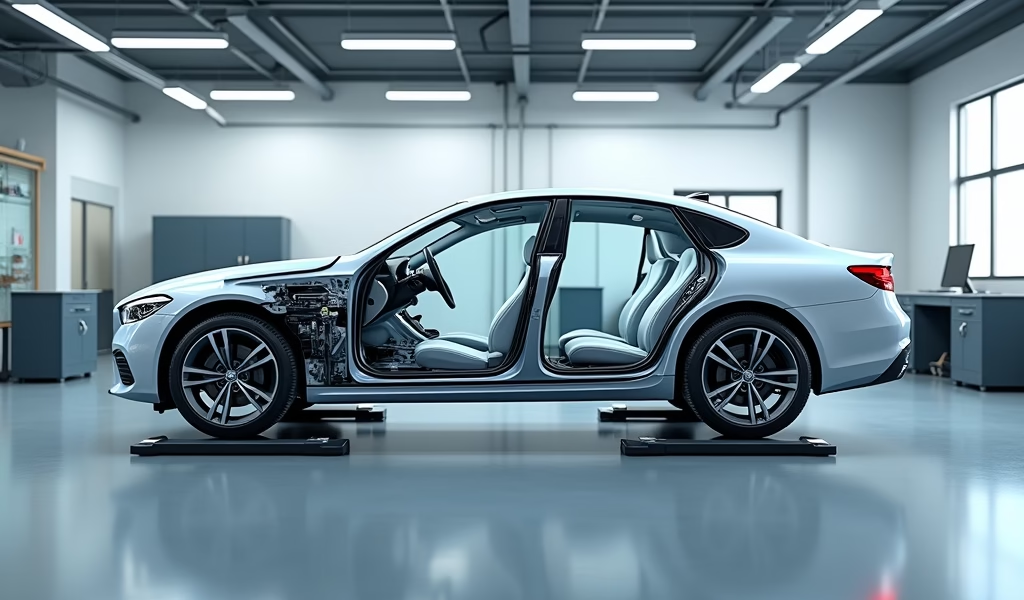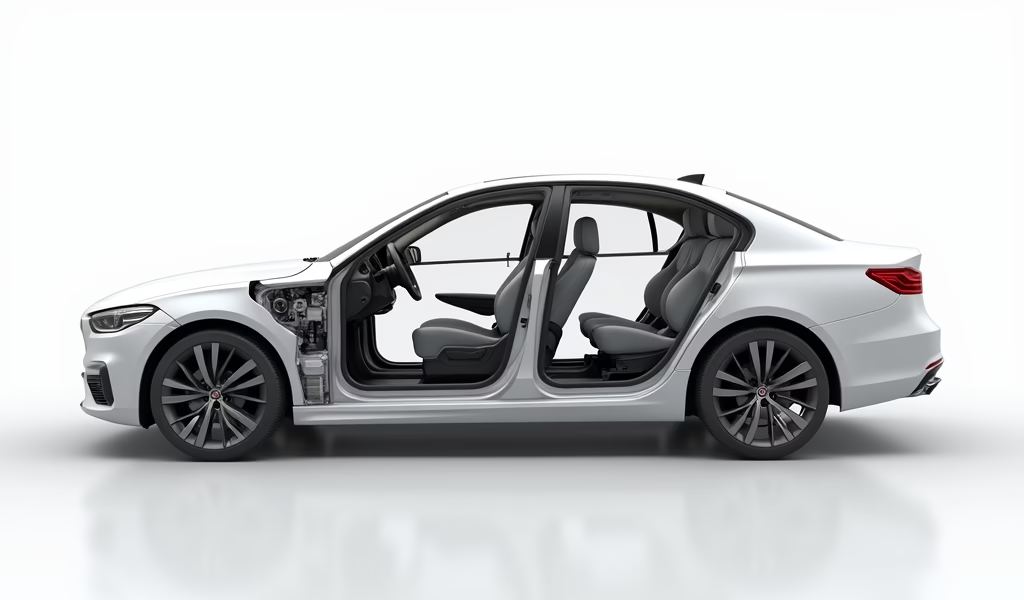Overview
This article examines five essential car safety features—Anti-lock Braking Systems (ABS), airbag systems, Electronic Stability Control, Advanced Driver Assistance Systems (ADAS), and Tire Pressure Monitoring Systems—explaining how they function and how drivers can maximize their effectiveness. The author emphasizes that while modern safety technologies provide significant protection, they work best when drivers understand their operation, maintain them properly, and recognize that these systems supplement rather than replace attentive driving practices.
Table of Contents
- Understanding Modern Car Safety: More Than Just Airbags
- Anti-lock Braking System (ABS): Your Guardian in Emergency Stops
- Airbag Systems: Positioning Matters for Maximum Protection
- Electronic Stability Control: Your Digital Co-Pilot
- Advanced Driver Assistance Systems: The Eyes You Didn’t Know You Had
- Tire Pressure Monitoring: The Foundation of Vehicle Safety
- Conclusion: Knowledge is Your Best Safety Feature
- Frequently Asked Questions
Understanding Modern Car Safety: More Than Just Airbags
Today’s vehicles are marvels of engineering when it comes to safety. Having spent 20+ years under the hood, I’ve witnessed the remarkable evolution from simple mechanical features to sophisticated computer-controlled systems that actively prevent accidents.
Modern cars don’t just protect you during a crash – they work constantly to prevent one from happening in the first place. This shift from passive to active safety has revolutionized what we can expect from our vehicles.
But here’s the thing: many drivers aren’t taking full advantage of these life-saving features simply because they don’t understand how they work. As someone who’s diagnosed countless vehicle issues, I can tell you that knowledge is your best protection on the road.
That’s why we’re diving into the five most important car safety features explained in simple terms. Whether you’re driving a brand-new model or something a few years older, understanding these systems can quite literally save your life.
Anti-lock Braking System (ABS): Your Guardian in Emergency Stops

Remember being taught to “pump the brakes” during emergency stops? That technique is now obsolete thanks to Anti-lock Braking Systems that do this job automatically – and far better than human reflexes ever could.
ABS prevents your wheels from locking up during hard braking. When wheels lock, you lose steering control and essentially become a passenger in your own vehicle. ABS rapidly pulses the brakes many times per second, maintaining traction while delivering maximum stopping power.
When ABS activates, you’ll feel vibration in the brake pedal – this is completely normal! Many drivers panic and release the brakes when they feel this feedback, defeating the system’s purpose. Instead, maintain firm, continuous pressure on the pedal while steering around obstacles.
For ABS to work properly:
- Apply firm, steady pressure to the brake pedal – don’t pump it
- Continue steering as needed – that’s the whole point of ABS
- Expect vibration and possibly noise – this means it’s working
- Keep your brake fluid fresh – change it every 2-3 years
In my workshop, I see countless vehicles with compromised ABS due to neglected brake fluid. This hygroscopic fluid absorbs moisture over time, leading to corrosion inside the system. According to NHTSA data, properly functioning brakes can reduce stopping distances by up to 20% in wet conditions.
One crucial tip: if your ABS warning light comes on, don’t ignore it. This isn’t a “fix it when convenient” situation – it means your emergency braking capabilities are compromised. Get it checked immediately.
Airbag Systems: Positioning Matters for Maximum Protection
Modern vehicles are essentially rolling pillows, with airbags strategically positioned throughout the cabin. While older cars might have had just two front airbags, today’s vehicles often pack 6-10 airbags, creating a protective cocoon during collisions.
What many drivers don’t realize is that proper positioning dramatically affects how well these systems protect you. I’ve investigated numerous accidents where improper seating position reduced airbag effectiveness or even caused injuries.
The ideal driver position is at least 10 inches from the steering wheel airbag. If you can’t maintain this distance while reaching the pedals comfortably, consider adjusting the steering column or using pedal extenders. Your arms should be slightly bent when gripping the wheel.
Surprisingly, the traditional “10 and 2” hand position is no longer recommended. Instead, position your hands at “9 and 3” to avoid having your arms flung into your face when airbags deploy.
For maximum airbag protection:
- Sit back at least 10 inches from the steering wheel
- Position hands at 9 and 3 o’clock on the steering wheel
- Keep children under 12 in the back seat, away from front airbags
- Never place rear-facing child seats in front of active airbags
- Ensure everyone is properly belted – airbags supplement seatbelts, not replace them
If your airbag warning light illuminates, don’t gamble with safety. This typically indicates a system fault that requires immediate professional attention. Research shows that frontal airbags reduce driver fatalities by 29% in frontal crashes – but only when functioning properly.
Electronic Stability Control: Your Digital Co-Pilot
Electronic Stability Control (ESC) might be the most underappreciated safety feature in modern vehicles. As someone who’s test-driven thousands of cars, I can tell you it’s like having a professional driver helping you maintain control in critical situations.
Think of ESC as your personal driving coach. It constantly compares your intended direction (where you’re steering) against your actual path. When it detects the beginning of a skid, it selectively applies individual wheel brakes and may reduce engine power to help you maintain control.
Many drivers confuse traction control with stability control. While related, they serve different purposes. Traction control prevents wheel spin during acceleration, while ESC prevents sideways skids and spinouts during turns or emergency maneuvers.
ESC is particularly valuable in these challenging scenarios:
- Wet, icy, or slippery road surfaces
- Emergency swerving to avoid obstacles
- Cornering too quickly for conditions
- Driving on changing road surfaces (like partially graveled roads)
One common misconception I hear in my shop: “My car has ESC, so I can drive normally in snow.” Wrong! ESC can only work within the laws of physics. It can’t create friction where none exists. Think of it as a safety net, not a performance enhancer.
While you can typically disable ESC temporarily (useful when rocking a car out of deep snow), I strongly recommend keeping it active during normal driving. Studies show ESC can reduce fatal single-vehicle crashes by up to 40% – an astonishing statistic that makes this feature one of the most significant safety advancements in decades.
Advanced Driver Assistance Systems: The Eyes You Didn’t Know You Had
Modern vehicles don’t just respond to accidents – they actively work to prevent them. Advanced Driver Assistance Systems (ADAS) use an array of sensors, cameras, and radars to monitor your surroundings and either alert you to danger or intervene if necessary.
As someone who diagnoses these sophisticated systems daily, I’m continually impressed by their capabilities. Yet I also see drivers who either don’t understand these features or rely on them too heavily.
The most common ADAS features include:
- Forward Collision Warning/Automatic Emergency Braking: Alerts you and may apply brakes when a collision is imminent
- Lane Departure Warning/Lane Keeping Assist: Alerts when you’re drifting from your lane and may gently steer you back
- Blind Spot Detection: Monitors those notorious blind zones where vehicles can hide
- Automatic High Beam Control: Toggles between high and low beams based on oncoming traffic
- Adaptive Cruise Control: Maintains not just speed but a safe following distance
- Animal Detection Capability: Advanced systems that can identify and respond to animals on the road
The critical thing to understand: these are assistance systems, not autonomous driving features. They supplement your attention but don’t replace it. I’ve seen accidents where drivers were overconfident in their vehicle’s capabilities.
To get the most from ADAS:
- Take time to learn your specific vehicle’s features and limitations
- Customize sensitivity settings to match your driving preferences
- Keep sensors and cameras clean, especially in winter
- Remember that bright sun, heavy rain, or snow can temporarily reduce system effectiveness
One often overlooked aspect: these systems need maintenance too. After windshield replacement, minor collisions, or even some bumper repairs, ADAS sensors may need recalibration. Skipping this step can lead to systems that don’t function correctly when you need them most.
Tire Pressure Monitoring: The Foundation of Vehicle Safety

If your vehicle’s safety features were a house, properly inflated tires would be its foundation. Everything from braking distance to handling stability depends on maintaining correct tire pressure.
That’s why Tire Pressure Monitoring Systems (TPMS) have been mandatory equipment on all new vehicles since 2007. This system continuously monitors your tire pressure and alerts you when any tire falls significantly below the recommended level.
In my repair shop, I frequently see drivers ignoring their TPMS warning light. “It’s just a little low,” they’ll say. What they don’t realize is that even 5-8 PSI below recommendation can increase braking distance by several feet – the difference between a close call and a collision.
When that TPMS light illuminates:
- Check all tire pressures as soon as safely possible
- Inflate to the pressure listed on your vehicle’s door jamb sticker (NOT the maximum on the tire)
- If the warning persists, have the system checked professionally
An important seasonal note: tire pressure typically drops about 1 PSI for every 10°F decrease in temperature. When autumn turns to winter, you might see that TPMS light simply due to colder weather. This doesn’t mean the system is malfunctioning – it’s doing exactly what it should by alerting you to add air.
Some vehicles have basic systems that only alert you to low pressure, while others display the actual pressure in each tire. Either way, this simple system provides crucial information that affects every aspect of your vehicle’s safety performance.
Conclusion: Knowledge is Your Best Safety Feature
The suite of safety technologies in modern vehicles is truly impressive, but like any tool, these features deliver their greatest benefit when properly understood. As a mechanic who’s seen both the miracle saves and the preventable tragedies, I can tell you that informed drivers are safer drivers.
Take some time to dust off your owner’s manual and understand the specific safety features in your vehicle. Each manufacturer implements these systems slightly differently, and knowing the nuances can make all the difference in an emergency situation.
Remember that even the most advanced safety technology serves to complement—not replace—safe driving practices. Maintaining proper following distance, staying alert, avoiding distractions, and driving appropriate to conditions remain your first line of defense.
Regular maintenance of these systems isn’t optional – it’s essential. From brake fluid changes that keep ABS functioning correctly to sensor calibrations that ensure your driver assistance systems work properly, preventative care ensures these features will perform when you need them most.
After all, the most important safety feature in any vehicle is still the driver. These systems are your partners in safety, but you’re still the captain of the ship. Drive well, stay informed, and stay safe out there.
Frequently Asked Questions
What is the most important car safety feature?
The seatbelt remains the most important safety feature in any vehicle. It works with other systems like airbags and crumple zones to keep you properly positioned during a collision.
Can I disable the electronic stability control in my car?
Most vehicles allow you to temporarily disable ESC, which can be useful when stuck in snow or mud. However, the system typically reactivates automatically when the vehicle reaches a certain speed or when the ignition is cycled.
How often should car safety systems be inspected?
Have safety systems inspected during regular maintenance, typically every 12 months or 12,000 miles. Any warning lights related to safety systems should prompt immediate professional inspection.
Does automatic emergency braking work in all conditions?
No, automatic emergency braking has limitations and may not function optimally in poor visibility, extreme weather, or at higher speeds. The system is designed as a last resort, not a substitute for attentive driving.
Are aftermarket safety devices as effective as factory-installed ones?
Aftermarket safety devices can be beneficial but typically aren’t as integrated or tested as factory systems. Factory-installed safety features are specifically engineered and calibrated for your particular vehicle model.

